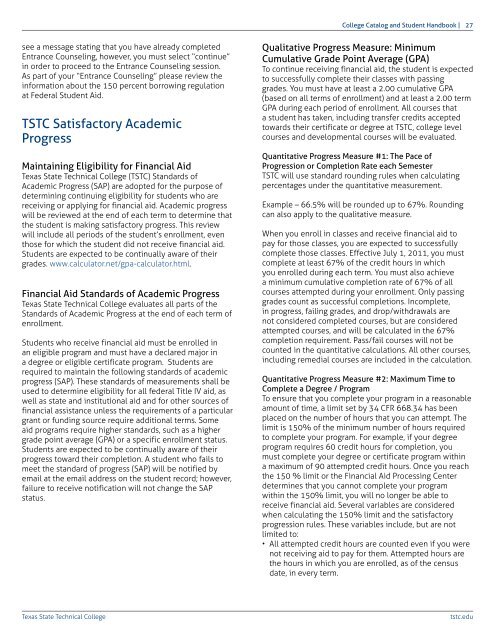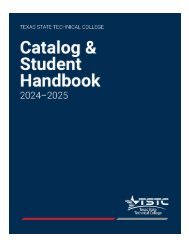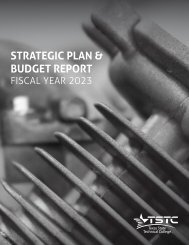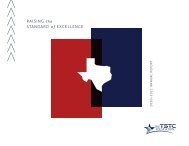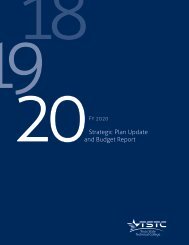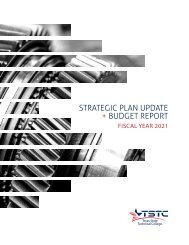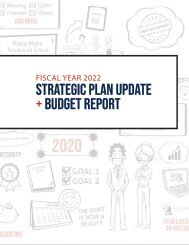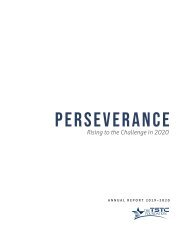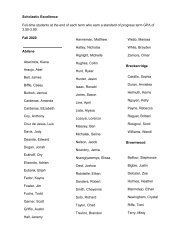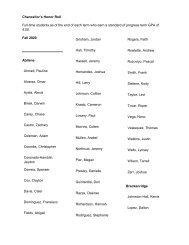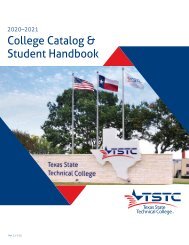Student Handbook and Catalog 2021-22 V2
You also want an ePaper? Increase the reach of your titles
YUMPU automatically turns print PDFs into web optimized ePapers that Google loves.
College <strong>Catalog</strong> <strong>and</strong> <strong>Student</strong> <strong>H<strong>and</strong>book</strong> | 27<br />
see a message stating that you have already completed<br />
Entrance Counseling, however, you must select “continue”<br />
in order to proceed to the Entrance Counseling session.<br />
As part of your “Entrance Counseling” please review the<br />
information about the 150 percent borrowing regulation<br />
at Federal <strong>Student</strong> Aid.<br />
TSTC Satisfactory Academic<br />
Progress<br />
Maintaining Eligibility for Financial Aid<br />
Texas State Technical College (TSTC) St<strong>and</strong>ards of<br />
Academic Progress (SAP) are adopted for the purpose of<br />
determining continuing eligibility for students who are<br />
receiving or applying for financial aid. Academic progress<br />
will be reviewed at the end of each term to determine that<br />
the student is making satisfactory progress. This review<br />
will include all periods of the student’s enrollment, even<br />
those for which the student did not receive financial aid.<br />
<strong>Student</strong>s are expected to be continually aware of their<br />
grades. www.calculator.net/gpa-calculator.html.<br />
Financial Aid St<strong>and</strong>ards of Academic Progress<br />
Texas State Technical College evaluates all parts of the<br />
St<strong>and</strong>ards of Academic Progress at the end of each term of<br />
enrollment.<br />
<strong>Student</strong>s who receive financial aid must be enrolled in<br />
an eligible program <strong>and</strong> must have a declared major in<br />
a degree or eligible certificate program. <strong>Student</strong>s are<br />
required to maintain the following st<strong>and</strong>ards of academic<br />
progress (SAP). These st<strong>and</strong>ards of measurements shall be<br />
used to determine eligibility for all federal Title IV aid, as<br />
well as state <strong>and</strong> institutional aid <strong>and</strong> for other sources of<br />
financial assistance unless the requirements of a particular<br />
grant or funding source require additional terms. Some<br />
aid programs require higher st<strong>and</strong>ards, such as a higher<br />
grade point average (GPA) or a specific enrollment status.<br />
<strong>Student</strong>s are expected to be continually aware of their<br />
progress toward their completion. A student who fails to<br />
meet the st<strong>and</strong>ard of progress (SAP) will be notified by<br />
email at the email address on the student record; however,<br />
failure to receive notification will not change the SAP<br />
status.<br />
Qualitative Progress Measure: Minimum<br />
Cumulative Grade Point Average (GPA)<br />
To continue receiving financial aid, the student is expected<br />
to successfully complete their classes with passing<br />
grades. You must have at least a 2.00 cumulative GPA<br />
(based on all terms of enrollment) <strong>and</strong> at least a 2.00 term<br />
GPA during each period of enrollment. All courses that<br />
a student has taken, including transfer credits accepted<br />
towards their certificate or degree at TSTC, college level<br />
courses <strong>and</strong> developmental courses will be evaluated.<br />
Quantitative Progress Measure #1: The Pace of<br />
Progression or Completion Rate each Semester<br />
TSTC will use st<strong>and</strong>ard rounding rules when calculating<br />
percentages under the quantitative measurement.<br />
Example – 66.5% will be rounded up to 67%. Rounding<br />
can also apply to the qualitative measure.<br />
When you enroll in classes <strong>and</strong> receive financial aid to<br />
pay for those classes, you are expected to successfully<br />
complete those classes. Effective July 1, 2011, you must<br />
complete at least 67% of the credit hours in which<br />
you enrolled during each term. You must also achieve<br />
a minimum cumulative completion rate of 67% of all<br />
courses attempted during your enrollment. Only passing<br />
grades count as successful completions. Incomplete,<br />
in progress, failing grades, <strong>and</strong> drop/withdrawals are<br />
not considered completed courses, but are considered<br />
attempted courses, <strong>and</strong> will be calculated in the 67%<br />
completion requirement. Pass/fail courses will not be<br />
counted in the quantitative calculations. All other courses,<br />
including remedial courses are included in the calculation.<br />
Quantitative Progress Measure #2: Maximum Time to<br />
Complete a Degree / Program<br />
To ensure that you complete your program in a reasonable<br />
amount of time, a limit set by 34 CFR 668.34 has been<br />
placed on the number of hours that you can attempt. The<br />
limit is 150% of the minimum number of hours required<br />
to complete your program. For example, if your degree<br />
program requires 60 credit hours for completion, you<br />
must complete your degree or certificate program within<br />
a maximum of 90 attempted credit hours. Once you reach<br />
the 150 % limit or the Financial Aid Processing Center<br />
determines that you cannot complete your program<br />
within the 150% limit, you will no longer be able to<br />
receive financial aid. Several variables are considered<br />
when calculating the 150% limit <strong>and</strong> the satisfactory<br />
progression rules. These variables include, but are not<br />
limited to:<br />
• All attempted credit hours are counted even if you were<br />
not receiving aid to pay for them. Attempted hours are<br />
the hours in which you are enrolled, as of the census<br />
date, in every term.<br />
Texas State Technical College<br />
tstc.edu


